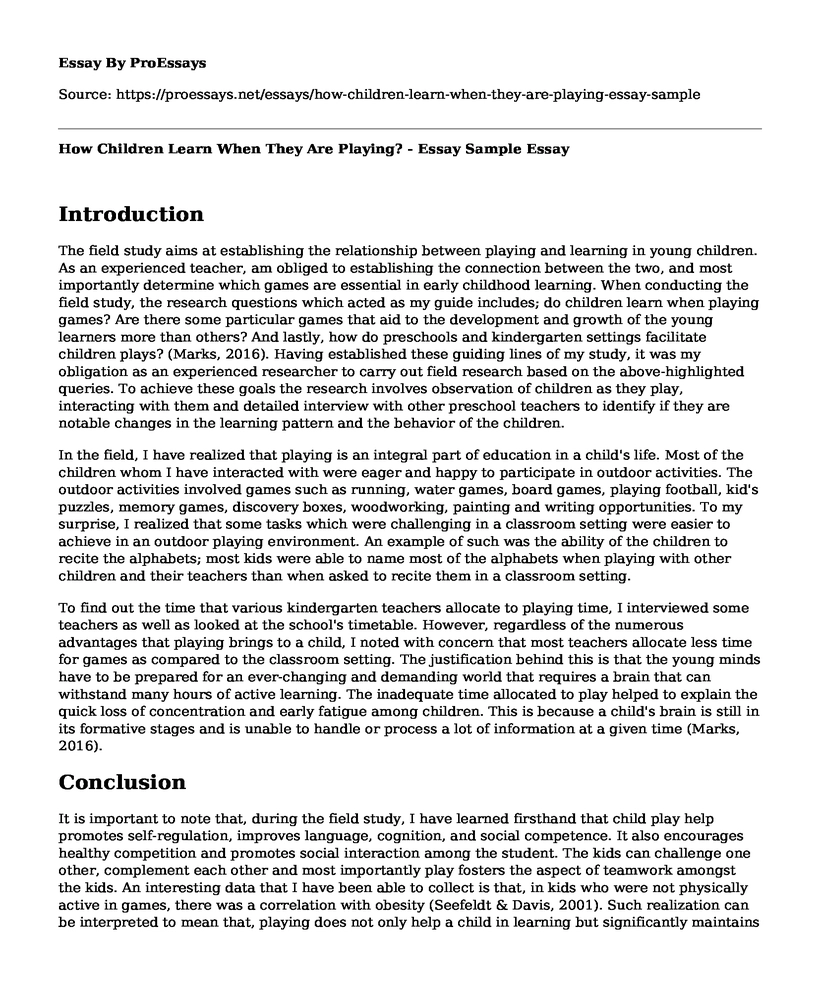Introduction
The field study aims at establishing the relationship between playing and learning in young children. As an experienced teacher, am obliged to establishing the connection between the two, and most importantly determine which games are essential in early childhood learning. When conducting the field study, the research questions which acted as my guide includes; do children learn when playing games? Are there some particular games that aid to the development and growth of the young learners more than others? And lastly, how do preschools and kindergarten settings facilitate children plays? (Marks, 2016). Having established these guiding lines of my study, it was my obligation as an experienced researcher to carry out field research based on the above-highlighted queries. To achieve these goals the research involves observation of children as they play, interacting with them and detailed interview with other preschool teachers to identify if they are notable changes in the learning pattern and the behavior of the children.
In the field, I have realized that playing is an integral part of education in a child's life. Most of the children whom I have interacted with were eager and happy to participate in outdoor activities. The outdoor activities involved games such as running, water games, board games, playing football, kid's puzzles, memory games, discovery boxes, woodworking, painting and writing opportunities. To my surprise, I realized that some tasks which were challenging in a classroom setting were easier to achieve in an outdoor playing environment. An example of such was the ability of the children to recite the alphabets; most kids were able to name most of the alphabets when playing with other children and their teachers than when asked to recite them in a classroom setting.
To find out the time that various kindergarten teachers allocate to playing time, I interviewed some teachers as well as looked at the school's timetable. However, regardless of the numerous advantages that playing brings to a child, I noted with concern that most teachers allocate less time for games as compared to the classroom setting. The justification behind this is that the young minds have to be prepared for an ever-changing and demanding world that requires a brain that can withstand many hours of active learning. The inadequate time allocated to play helped to explain the quick loss of concentration and early fatigue among children. This is because a child's brain is still in its formative stages and is unable to handle or process a lot of information at a given time (Marks, 2016).
Conclusion
It is important to note that, during the field study, I have learned firsthand that child play help promotes self-regulation, improves language, cognition, and social competence. It also encourages healthy competition and promotes social interaction among the student. The kids can challenge one other, complement each other and most importantly play fosters the aspect of teamwork amongst the kids. An interesting data that I have been able to collect is that, in kids who were not physically active in games, there was a correlation with obesity (Seefeldt & Davis, 2001). Such realization can be interpreted to mean that, playing does not only help a child in learning but significantly maintains the physical and mental fitness of a child.
Therefore, it is paramount to review the school's timetables and the different approach that teachers employ when teaching children. As evident in my observation, children can learn more when playing than when in a classroom setting. More time needs to be allocated to children's play where the teachers and students can interact more freely. The happiest children according to my observation are the ones that are given enough time to play and be creative (Tinsley, n.d.).
References
Marks, L. (2016). Playing to Learn: an overview of the Montessori Approach with pre-school children with Autism Spectrum Condition. Support for Learning, 31(4), 313-328. doi:10.1111/1467-9604.12140
Seefeldt, C., & Davis, K. (2001). Playing to learn. Beltsville, MD: Gryphon House.
Tinsley, B. J. (n.d.). How Children Learn to Be Healthy. How Children Learn to be Healthy, xv-xvi. doi:10.1017/cbo9780511499807.012
Cite this page
How Children Learn When They Are Playing? - Essay Sample. (2022, Apr 07). Retrieved from https://proessays.net/essays/how-children-learn-when-they-are-playing-essay-sample
If you are the original author of this essay and no longer wish to have it published on the ProEssays website, please click below to request its removal:
- Social Learning and the Virtual World Literature Review Paper Example
- College Education Should Be Free - Persuasive Essay
- The Austroasiatics in Ancient South China: Some Lexical Evidence Paper Example
- Personal Statement on University of Westminster
- Essay Sample on Childhood Trauma: Acute, Chronic & Complex Effects on Wellness
- School Medical Care: Protecting At-Risk Children - Essay Sample
- Paper Example on Setting Up Literacy Stations: Benefits & Guidelines







